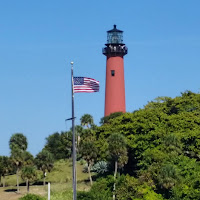Jupiter Lighthouse and Museum
Jupiter (Palm Beach County), Florida
Loxahatchee River Historical Society
www.jupiterlighthouse.org
Call for tour information (561) 747-8380
By Jane Feehan
The Jupiter Lighthouse, one of 29 in Florida, overlooks the beautiful aqua waters of the Jupiter Inlet. Preserved and operated by the Loxahatchee River Historical Society, the Jupiter Lighthouse with its surrounding 126 acres has been declared an “Outstanding Natural Area,” the second such designation for a lighthouse in the U.S. and the first east of the Mississippi River.
The site for the lighthouse was chosen in 1853. It was designed by Lieutenant George Gordon Meade (1815-1872) who worked for the U.S. Army Corps of Topographical Engineers. As major general, Meade defeated Gen. Robert E. Lee at the Civil War Battle of Gettysburg in 1863.
Call for tour information (561) 747-8380
By Jane Feehan
The Jupiter Lighthouse, one of 29 in Florida, overlooks the beautiful aqua waters of the Jupiter Inlet. Preserved and operated by the Loxahatchee River Historical Society, the Jupiter Lighthouse with its surrounding 126 acres has been declared an “Outstanding Natural Area,” the second such designation for a lighthouse in the U.S. and the first east of the Mississippi River.
The site for the lighthouse was chosen in 1853. It was designed by Lieutenant George Gordon Meade (1815-1872) who worked for the U.S. Army Corps of Topographical Engineers. As major general, Meade defeated Gen. Robert E. Lee at the Civil War Battle of Gettysburg in 1863.
The lighthouse, one of six lighthouse projects assigned to Meade, opened July 10, 1860. The structure reportedly cost $68,000 and today, after several upgrades, stands at 108 feet or 156 feet above sea level.
Operation of the lighthouse was suspended from 1861-1866 when Confederate sympathizers stole its 880 candle power lights (250-watt bulb). A wireless radio beacon was installed in 1905 to guide ships. Lots more information--a timeline and colorful facts about Jupiter Lighthouse--can be found at Jupiterlighthouse.org.
 |
| Wreck of the Mary Kingsland, Florida State Archives |
According to the story, they were refused assistance.They returned to the beached yacht with a "wrecker," or scavenger from the area. It's not clear why the lighthouse keeper denied the Scott family assistance. Perhaps he was trying to drum up business for the "wrecker." Shipwreck scavenging served as a source of income in Florida at that time.
The news account reported the family, including a child, were "exposed to attacks by wild beasts and Indians. They remained near the wreck eating palmetto tops and wild cabbage until the Cahawba, on its way to Havana, rescued them." Their wait for help was just a few days. The yacht and personal property aboard, valued at $4,000, was deemed a total loss.
Over the years there have been a number of wrecks along the coast near Jupiter, thus the need for the lighthouse. Today, a museum on the property highlights history of the American Indians who once lived in the area, the Seminole Wars of the 1800s, Jupiter families, and World War II uses of the lighthouse.
Many visitors combine the lighthouse tour with a swim in the clear inlet – a great respite in hot summer months. Picnics permitted; grills are not. There’s plenty of seating and things to do if a climb to the top of the lighthouse is not on your agenda or not possible during the pandemic.
 |
| Stairs in the lighthouse |
Copyright © 2021. All rights reserved. Jane Feehan
Sources:
Cincinnati Daily Press, March 28, 1861Palm Beach Post, Aug. 4, 1964
Miami Herald, June 12, 1966
More information about Florida lighthouses:
https://www.visitflorida.com/travel-ideas/articles/arts-history-6-family-friendly-florida-lighthouses/
Tags: Florida history, lighthouses,
Jupiter history, Palm Beach County history
